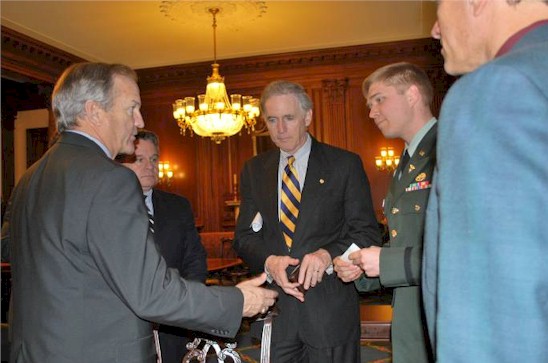Energy Psychology’s Magical Mystery Tour of the U.S. Congress
David Feinstein, Ph.D.
After some 30 phone calls to members of Congress trying to set up meetings to plead the case that Energy Psychology is superior to conventional treatments for soldiers and veterans suffering with PTSD, Dawson Church and I had managed to arrange only one appointment, and a tentative one at that since members of Congress may be called to the floor at any time for a vote. Worse, when we arrived (Wednesday, March 24, 2010, three days after passage of the Health Care bill) at Congressman Bob Filner’s door on the fourth floor of the House Office Building, we were told by a prim female aide who was clearly accustomed to shooing away people wanting to see the Congressman, the Chairman of the House Committee on Veterans’ Affairs, that we were not on the appointment calendar, it was a busy day, and there was zero chance we could have even a five-minute meeting, no matter how long we were willing to wait.
On to Plan B. Dawson knew Congresswomen Lynn Woolsey from his own district in Santa Rosa, California. We went to her office on the second floor, hoping that even though we hadn’t been successful in attempting to arrange a meeting in advance, we might be able to drop in based on Dawson’s being in her district and having had previous collaborations with her. The Congresswoman had been a strong supporter of “The Family Connection,” a nonprofit which had consistently been voted by the community’s other organizations as the county’s “most admired nonprofit.” Dawson had served as its president. But again staffers were to tell us: “busy day” and “no chance” of even a brief meeting. Just the night before Dawson had been talking to me about how, when your vision goes against the odds, part of the journey is to accept defeats and disappointments with grace. And, indeed, today, despite being 0 for 2 on our scorecard of two, he still seemed undaunted, ready to enthusiastically knock on every door of the Congressional Offices if necessary. The Army Second Lieutenant we had brought with us, however, was incredulous that he was spending his day off trying to help us fulfill such a bumbling mission. “What is your plan of action, now?” he asked with icy courtesy after Dawson had hand-written the Congresswomen a long note saying he had been by. As we stepped out the door, not sure whether to turn left or right, we turned left and found ourselves in the path of the Congresswoman returning to her office. She recognized and hugged Dawson warmly. Within minutes the three of us were in the inner sanctums of her office with her and two male aides taking notes.
Our presentation was brief but effective, centering around the Second Lieutenant telling of his story. While serving as a guard and medic in Iraq, he was able to psychologically mobilize himself to perform his duties like a model soldier. He had enlisted in the Army and was deployed to the “Triangle of Death” in Baghdad, where he served in 2006 and 2007. He attended to mass casualties and encountered many bloodied, burned, and dead bodies. The first casualty he witnessed was a member of his unit who had half his head blown off. It was a time when fellow soldiers were being kidnapped and beheaded. At night, lying in his tent, in an area being heavily bombed, he explained what goes on in the mind: “When the sound of a whizzing rocket fills the air, if you hear an explosion three seconds later, you are alive. If you don’t, you are dead.” Upon returning to the U.S., safety did not provide comfort. In a classroom or other public setting, he would be calculating his response should there be an attack. Sirens were now the screams of approaching rockets. An ebullient personality before the war, his inner life had become dry and restricted. He no longer found himself laughing. He realized in retrospect that he had become dissociated from his body. He gradually came to accept that his undiagnosed PTSD was his new way of life. Having become an officer, and in training now to become a physician, he knew that reporting a psychological difficulty of this magnitude could have a devastating impact on his career.
About a year after returning from Iraq, a friend commented on how he had changed. She offered to try a technique that she thought might be helpful. This led to a three-hour session of EFT (a form of Energy Psychology) where he made a list of every trauma he experienced during the war. Giving a 0-to-10 “subjective units of distress” rating to the first item on his list, he reported that it was a 0. He felt no distress in his (dissociated) body. His friend had him tap on the memory anyway. Within minutes he was sobbing, feeling the full impact of the memory, as high a 10 as could be imagined. For three hours they went through and, by tapping on acupuncture points, emotionally neutralized every memory on his list. He described how one of the first things he noticed as the session progressed was a return of sensation in his hands. He said it was like he was back in his body. By the end of that single session (followed by a brief follow-up session the next day), he was cured of all his symptoms of PTSD. Now nearly two years later, although his friend would be happy to provide follow-up at any point, he has been his joyful self again, no longer hypervigilant, and in no need of further help.
Dawson followed with a brief description of the research he has conducted demonstrating that the poignant story just told was not an isolated incident but rather an example of a reliable and unusually effective treatment for PTSD. He described the Iraq Vets Stress Project, which has offered free Energy Psychology treatment to hundreds of veterans through an international network of more than 100 providers, with many VA therapists referring veterans for treatment (www.StressProject.org). I put the meaning of that research into the context of conventional clinical practices. Congressman Woolsey was obviously impressed, but she also made it clear that she was not the one we needed to impress. She is on the House Labor and Employment Committee. We needed to engage members of committees that could make an impact on the care provided soldiers and veterans. She and her aides started naming the people they thought we should visit. She could only sympathize with us regarding how difficult it is to get an appointment, but she did offer to personally hand some of these Congressmen the research documentation we had brought. By the end of the day she had, on the floor of the House, initiated personal talks with three key committee leaders and handed them our research summary. But these are dry documents, and we still had no means for personally visiting with them.
Following this fortuitous but inconclusive meeting, we found ourselves again in the proverbial halls of Congress with no plan of action. But timing, coincidence, and who knows what else were to shape the rest of our day. Last January, a staffer to Congressman Dan Lungren, a Republican on the House Homeland Security and Judiciary Committees, had attended a small, intimate conference in Costa Rica where my wife, Donna Eden, and I were presenters. I had shown a video of veterans who were treated with PTSD and it had caught her attention and her passion. Congressman Lungren cares very deeply about the plight of returning veterans and Sandra wanted to bring our work to his attention. Two months later, however, their office had been fully immersed in the pending health care legislation and many other projects, and there had not been time to give much focus to the strange new treatment she had witnessed in Costa Rica. As we were leaving Congresswoman Woolsey’s office, the office next door, by coincidence, was Congressman Lungren’s office. I said, “Let me stop by and say ‘Hello’ to a friend who works there.” We were told that Sandra was away. So off we went to the elevator, where we would once more need to regroup. About 30 seconds later, Sandra walked out of the elevator, gave a little shriek of surprise on seeing me, and hugged me enthusiastically. She explained that part of the strength of her response is that she was just a few minutes earlier thinking about walking to the Veterans’ Affairs Office to try to present to them what she had seen in Costa Rica. And suddenly, there I was.
We were soon in her office giving the presentation that had just impressed Congresswomen Woolsey. We would be giving variations of that presentation five more times that day. Sandra said, “I want Congressman Lungren to hear this.” She checked with the person who keeps his schedule, and there was no way to fit us in. She initiated an alternative plan, whisking us away to a security clearance area and then to the Rayburn Room, a large, busy area which is just off the House Congressional Chamber. Congress members can easily duck out of the Chamber between votes for small impromptu meetings. The place bustles with a strange mix of informality and importance.
Sandra’s office had gotten a message to Congressman Lungren to meet us there. We arrived via the underground trolley for Congress members and staff that runs between the House Offices and the Capitol Building. We waited a few minutes, and suddenly, there was the Congressman, who had a way of being that, despite my strong antipathy in recent years toward his political party, soon had me thinking, “I could see voting for this man!” He listened with obvious interest and empathy as the lieutenant told his story. The Congressman responded by relating stories from his own family that were highly pertinent to the discussion, but he then posed one of the key dilemmas for Energy Psychology’s acceptance. “It sounds too simple! Too good to be true!” He let us know he would like to believe there is a simple cure for PTSD, but he would need a lot more convincing. The ensuing discussion was brief, frank, and to the point, starting with our agreement that the field does indeed face this odd credibility problem that its methods are so fast and effective that people don’t find the personal accounts or even the existing research to be plausible. We also addressed a second very astute concern that the Congressman raised. Would this treatment impair a soldier’s performance on the battlefield? We argued that it would not. PTSD does not increase a soldier’s effectiveness. He conceded that point. At the end, we knew he felt warmly toward the lieutenant and he appeared to be expressing respect for me and Dawson, but we had no idea if we had convinced him.
Back to Sandra’s office. We were all three impressed as we watched the wheels in her mind strategizing ways of making the best use of our visit. She told us to go get some lunch while she took the next steps (meanwhile, shuffling her appointments for the day so she could maximize the amount of time she could give to us). When we returned, Sandra had good news. The Congressman wanted to introduce us to some of his House colleagues. Back to the Rayburn Room. One at a time, between votes on the House Floor, Congressman Lungren brought us to meet, in succession, a member of the House Armed Services Committee (who had previously served with the Marines in Iraq), a former chair and now the second ranking member of the House Veterans’ Affairs Committee, another member of that Committee, and a member of the House Budget and Appropriations Committee. We told each one our story and fielded their questions. Sandra is a seasoned Congressional staffer who later told us how improbable it was that things could have come together for our visit as they did – it was almost as if the timing of the House votes had been orchestrated to make all this possible.
According to a recent article in the Journal of Traumatic Stress, only one in ten veterans who enters treatment for PTSD in the V.A. actually completes it. Each of the Congressmen we met was clearly interested in a better treatment approach to PTSD, and each seemed to leave with a sense that evidence for one may be sitting there in the Rayburn Room. Congressman Lungren brought us both Republican and Democratic colleagues, and Sandra explained that it is a welcome opportunity to have an issue that cuts across party lines. Two of the Congressmen gave the lieutenant their personal e-mail address, asking for follow-up, and one of them said he would be calling the EFT practitioner who had given the lieutenant the session that had cured his PTSD almost two years earlier.
We don’t know what will emerge from this Magical Mystery Tour of Congress by a couple of Energy Psych therapists/researchers who don’t know poly sci from polymers, but Sandra assured us that she now had what she needed to set some things into motion. The very next day we received a call from the lieutenant. He and Dawson had been stonewalled by bureaucratic obstacles for a year in their efforts to institute a research study at Walter Reed, and their proposal had finally been rejected. He relayed that the morning following our visit to Congress, the doors had been opened wide for the study’s consideration. The commanding officer had appointed a colonel to coordinate a study of Energy Psychology within Walter Reed and requested that the initial paperwork be submitted by the following week. Dawson will be the Principal Investigator and the lieutenant the On-Site Investigator. The lieutenant didn’t indicate exactly what caused the military wheels to suddenly bounce into action so quickly after the year of intense effort that had gone nowhere, but we could only imagine that in his low-key way, he had successfully conveyed to his superiors that when Congress asks if they are aware of this new tapping therapy, that they might want to be sure they have the right answer.



| Met with: |
| Duncan Hunter, R-San Diego, former Marine, Iraq, House Armed Services Committee |
| Chris Smith, R-New Jersey, former chair of House Veterans Affairs Committee |
| Dan Lungren, R-SAC, House Homeland Security and Judiciary Committees |
| Chet Edwards, D-TX, House Budget and Appropriations Committees |
| Cliff Stearns, R-FL, House Veterans Affairs Committee |
| Lynn Woolsey, D-Petaluma, House Labor & Employment Committee |

